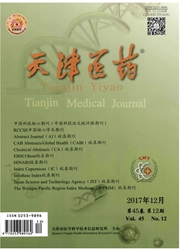

 中文摘要:
中文摘要:
目的研究在成骨细胞一破骨细胞共培养体系中,柚皮苷对成骨细胞活性和破骨细胞分化的影响。方法将成骨细胞(MC3T3-E1细胞株)和破骨细胞(RAW264.7细胞株)以2:1的比例分别培养至Transwell小室的上室和下室。根据培养基是否含有柚皮苷分为对照组和柚皮苷(2ng/ml组、20ng/ml组、200ng/ml组),培养7d后对下室破骨细胞进行TRAP染色和骨吸收陷窝鉴定;荧光定量PCR分析成骨细胞骨保护素(osteoprotegerin,OPG)、核因子KB受体活化因子配体(receptor activator for nuclear factor-κB ligand,RANKL)基因和破骨细胞分化基因活化T细胞核因子-1(NFATc-1)、活化T细胞核因子-2(NFATc-2)和核因子κB受体激活蛋白(receptor activator of NF-κB,RANK)的相对表达量。结果与对照组相比,柚皮苷可以促进成骨细胞OPG、RANKL的表达量且可提高OPG/RANKL的比值,差异有统计学意义(尸〈0.05);20ng/ml柚皮苷TRAP(+)细胞数(5.824-3.37)明显少于对照组(20.56±7.69),差异有统计学意义(P〈0.05);柚皮苷可抑制破骨细胞NFATc-1、NFATc-2的表达,促进RANK的表达,差异有统计学意义(P〈0.05)。结论柚皮苷可促进共培养条件体系中成骨细胞OPG和RANKL的表达以及抑制破骨细胞的分化,与上调OPG/RANKL的比值有关。
 英文摘要:
英文摘要:
Objective To explore the effect of naringin on the osteoblast activity and differentiation of osteoclast in a co-culture system. Methods Osteoblasts (MC3T3-E1 cell line) and osteoclasts (RAW264.7 cell line) were separately cultured in the upper chamber and lower chamber of Transwell with proportion of 2:1, and divided into control group and naringin group according to whether the culture medium containing naringin. Three different doses of naringin (2 ng/ml, 20 ng/ ml, 200 ng/ml) were applied in naringin group. After 7 days of culturing, the osteoclasts were processed for TRAP staining and bone resorption lacunae identification. Fluorescent quantitative PCR were used to semiquantitative analysize the relative expression level of OPG, RANKL, NFATc-1, NFATc-2 and RANK (receptor activator of NF-κB). Results Compared to the control group, Naringin can promote the expression of OPG and RANKL and increase the ratio of OPG/RANKL in osteoblasts, with significant differences (P〈0.05). The number of TRAP(+) cells in Naringin group (20 ng/ml) (5.82±3.37) was less than that of control group (20.56± 7.69), and the difference was statistically significant (P〈0.05). Naringin can inhibit the expression of NFATc-1 and NFATc-2 in osteoclasts, while promoting the expression of RANK, and the difference is statistically significant (P〈0.05). Conclusion Naringin can promote the expression OPG and RANKL of osteoblasts and inhibiting osteoclast differentiation in co-culture system, which may be related to the increasement of OPG/RANKL ratio.
 同期刊论文项目
同期刊论文项目
 同项目期刊论文
同项目期刊论文
 期刊信息
期刊信息
